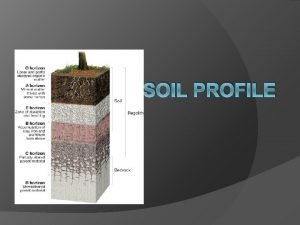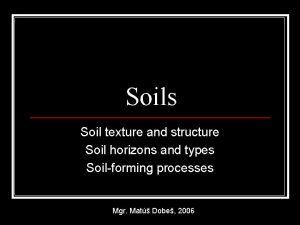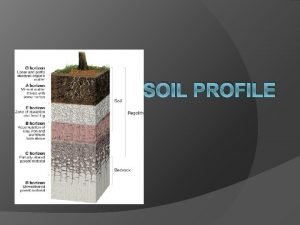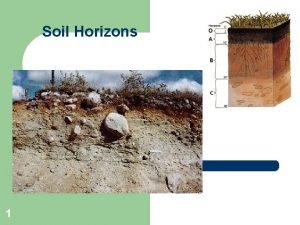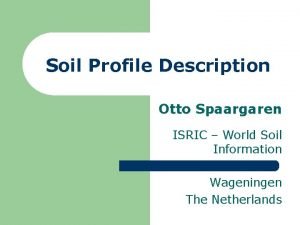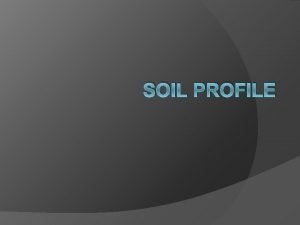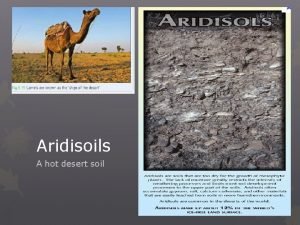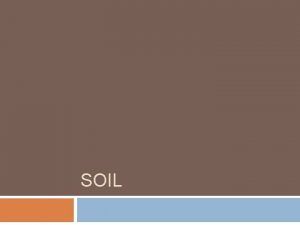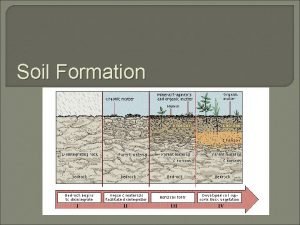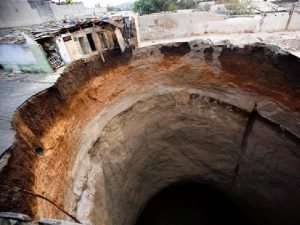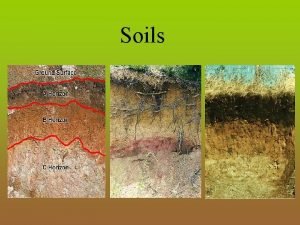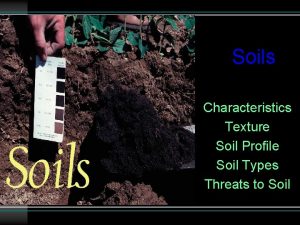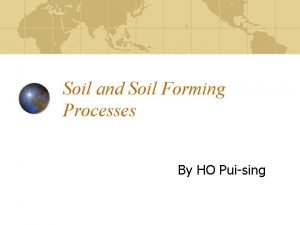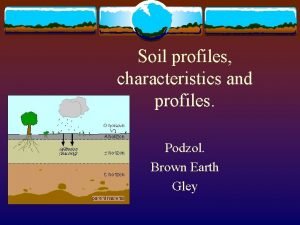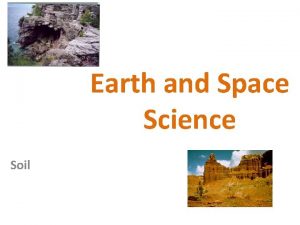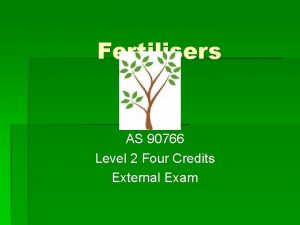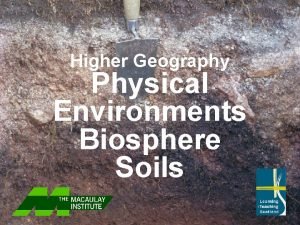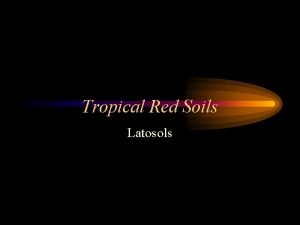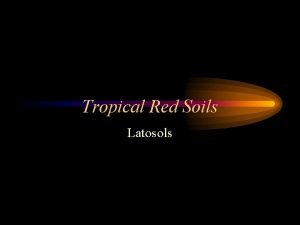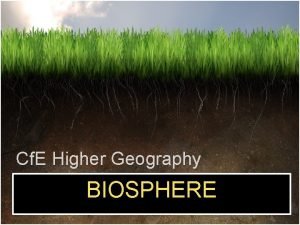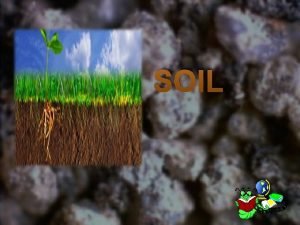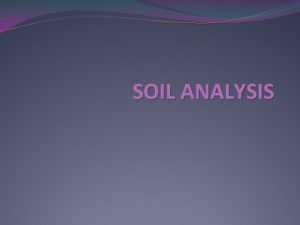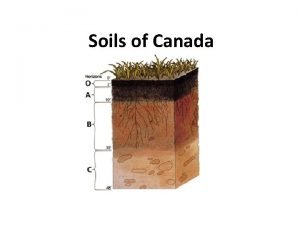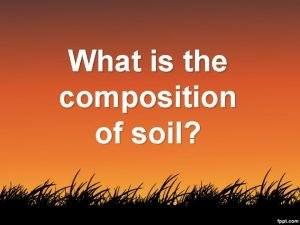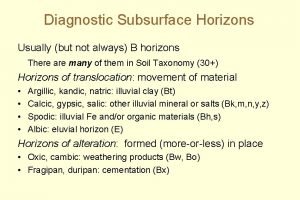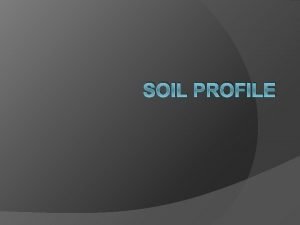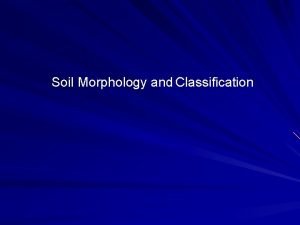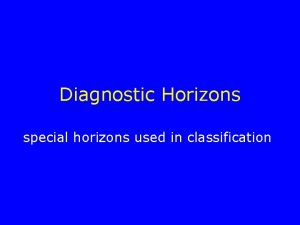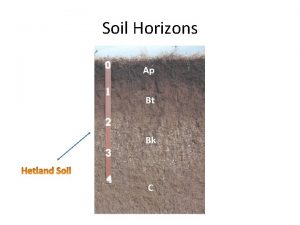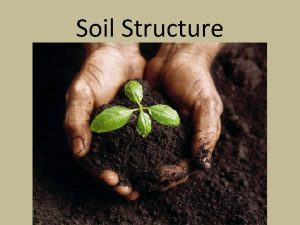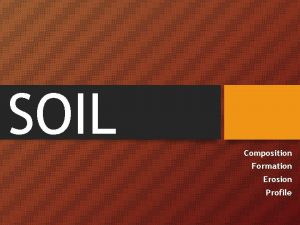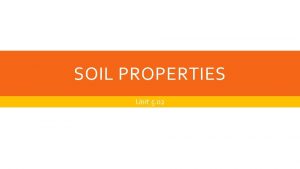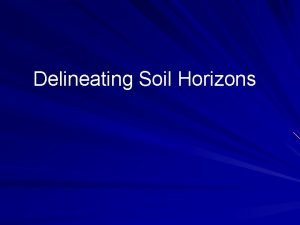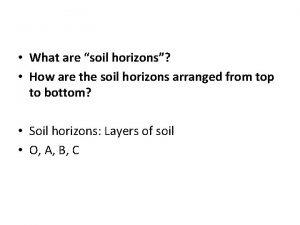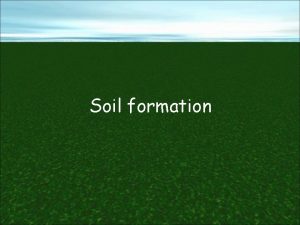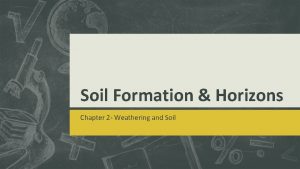SOIL PROFILE Soil genetic horizons HORIZON soil layer


























































- Slides: 58

SOIL PROFILE

Soil genetic horizons -HORIZON: soil layer parallel to surface with characteristics produced by soilforming processes

3 basic soil units (scale) Pedon: smallest volume called a soil Polypedon: soil body (2 or more pedons) in which soils are relatively uniform Soil Series: groups of like polypedons

profile: one side of pedon, showing all horizons; 2 -D





Master horizons O A E B C R Not every soil has all of these!!!

O horizon Organic material Same as litter layer or “duff”

Oi slightly decomposed (litter) : FIBRIC Oe intermediate decomposition: HEMIC Oa highly decomposed : SAPRIC Oi Oe Oa


A horizon (“TOPSOIL”) § topmost mineral horizon accumulation of well-decomposed O. M. § Often bioturbated § surface horizon disturbed by plowing (Ap)

A horizon in grassland

Buried A horizon Ab


E horizon § LOSS of § silicate clay, Fe & Al oxides, humus by eluviation § carbonates, gypsum by leaching

Leaching vs. eluviation LEACHING : removal of soluble minerals (Ca, Mg, Na) in solution ELUVIATION : loss (by water) of suspended materials (clay, humus, oxides) ”emigrating”

E horizon § lighter color than A § Because the colorful humus and Fe, Al oxides have eluviated away § coarser texture than B § Because the clay eluviated away

E horizon in forest soil



B horizon ACCUMULATED (illuviated ) ”immigration” silicate clay, Fe & Al oxides, carbonates, gypsum, humus § § distinguished from A or E: § stronger, redder, or darker color § OR different texture


Bh Has illuviated humus from E (dark, brown or black stain at top of B) Bs Has illuviated sesquioxides of Fe, Al from E (reddish color at top of B) Bhs Has both


E Bhs

O A E Bh Bs

E Bhs Bw

Bhs

A E Bhs

A E Bhs Bw

Bt An accumulation of silicate clay in B Can recognize it if you have clay in the B but not as much clay in the A ; can see clay skins Called an “argillic” horizon



Bk Has precipitated carbonates in it; White nodules or streaks Strongly effervescent


w : used if you see a change in B that is not accounted for by other subhorizon letters Bw If you see changes in color, texture, structure within a B



C horizon § Mineral horizon (not bedrock) underlying A, E, B horizons § not affected by soil-forming processes § may be parent material


R horizon Consolidated rock

Transitional horizons Zone of transition between master horizons AB A B; A dominates BA A B; B dominates AC A C; A dominates EB E B; E dominates etc….


Mixed horizons One horizon scattered within another horizon B/A mixed A&B; B is matrix for A E/B E is matrix etc….


Numbers after letters Changes within master horizon for which there is no subhorizon designation e. g. , A 1 A 2 for color change within A


g ss o n Additional subhorizons that you will need to know:


g : gleying Wet; grey; below water table Bg

ss : slickensides Shiny surfaces on clay peds that have Rubbed against one another, polishing the surfaces

o : all Fe, Al oxides Red, tropical Bo

Bss In Agassiz clay

n : accumulation of sodium (Na) Usually found in dry grassland or arid regions

Identifying horizons in the field

some terminology… Colloidal : submicroscopic humus and clay are colloidal Humus: ultimate stage of organic decay predominately protein, gums, lignin Sesquioxides: 1½ oxygens for each Fe, Al sesquioxides of Fe, Al: Fe 2 O 3 Al 2 O 3
 Master horizons
Master horizons Soil horizons
Soil horizons O a e b c r soil
O a e b c r soil Oaebcr
Oaebcr Soil horizons
Soil horizons Oaebcr soil
Oaebcr soil Desert soil formation
Desert soil formation Genetic programming vs genetic algorithm
Genetic programming vs genetic algorithm Genetic programming vs genetic algorithm
Genetic programming vs genetic algorithm A gene pool consists of
A gene pool consists of Genetic drift vs flow
Genetic drift vs flow Genetic drift vs genetic flow
Genetic drift vs genetic flow Why is soil a nonrenewable resource
Why is soil a nonrenewable resource Soil formation
Soil formation Soil food web horizon
Soil food web horizon A horizon soil
A horizon soil Soil health
Soil health Regolith soil horizon
Regolith soil horizon Soil horizon parent material
Soil horizon parent material Soil horizon foldable
Soil horizon foldable Soil structure ppt
Soil structure ppt Transition area between soil and parent material
Transition area between soil and parent material Pathway of food from mouth to anus
Pathway of food from mouth to anus Secure socket layer and transport layer security
Secure socket layer and transport layer security Layer-by-layer assembly
Layer-by-layer assembly Secure socket layer and transport layer security
Secure socket layer and transport layer security Layer 2 vs layer 3 bitstream
Layer 2 vs layer 3 bitstream Secure socket layer and transport layer security
Secure socket layer and transport layer security Presentation layer functions
Presentation layer functions Layer 2 e layer 3
Layer 2 e layer 3 Fig 19
Fig 19 Secure socket layer and transport layer security
Secure socket layer and transport layer security Brown earth soil profile
Brown earth soil profile Soil profile
Soil profile Regolith in soil profile
Regolith in soil profile Podzol soil profile
Podzol soil profile Soil profile
Soil profile Clay soil profile
Clay soil profile Gley soil profile diagram
Gley soil profile diagram Latosol soil
Latosol soil Latosol soil profile
Latosol soil profile Higher geography biosphere
Higher geography biosphere A horizon
A horizon What is soil made of?
What is soil made of? Top layer soil
Top layer soil Deepest layer of soil
Deepest layer of soil Mortimer wheelar used scientific and soil layer method
Mortimer wheelar used scientific and soil layer method Layer of soil
Layer of soil 3 horizon framework
3 horizon framework Diagnostic subsurface horizons
Diagnostic subsurface horizons Topmost mineral horizon
Topmost mineral horizon What are the master horizons?
What are the master horizons? Pennine horizons digital archive
Pennine horizons digital archive Ucsf day care
Ucsf day care Guardian consonant
Guardian consonant Lean horizons consulting
Lean horizons consulting Imperial horizons
Imperial horizons Limitless horizons ixil
Limitless horizons ixil Diagnostic horizons
Diagnostic horizons
